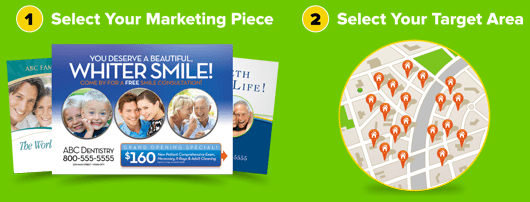
When it comes to marketing your products or services, there are 2 basic challenges:
- How do you obtain new customers or clients?
(By survey, this is the biggest concern for small businesses.) - How do you get your existing customers to come back for more?
(This is not given nearly the importance it deserves by small business owners.)
The direct mail postcard, when used correctly, answers both of these challenges admirably.
Nike hit a popular slogan when they coined the phrase, “Just Do It.” But in direct mail, we use a slightly more effective expression, “Do it Right.” The difference between just doing it and doing it right is the difference between going through the motions and your sales going through the roof!
For example, the other day I received a postcard advertising a copy machine. It had teeny, tiny lettering slathered all over the front and a large portion of the back of the card. It was extremely hard to read. As a result, I threw it away.
Several days later, I received a postcard with just 32 words on it. It quickly informed me I could get complete information on unrestricted, unlimited long distance telephone service for $14.95 per month by calling the 800-number on the card. How did I respond? I called. I got the information, had my questions answered and ordered — and that simply, my long distance service changed.
What was the difference in my two responses? Why did one card go in the trash and another in the “To Do’ pile? The company who offered me the long distance service was using a time-tested, two-step selling process:

Step two was provided to me on the phone by one of their sales representatives, who answered my questions and made me feel confident I could save quite a bit of money on my long distance bill and that the service would be as good or better as my current one.
Why Exactly Does Two-Step Marketing Work?
A process that involves two steps allows a person to get comfortable before plunking down their hard-earned cash. Think about it, and you´ll find most of life´s biggest moments come in two stages. Like getting married or having a child, there is usually a “warming up’ period to smooth the transition into the next stage.
Likewise, postcard marketing has two steps: step one is generating a lead; step two is providing the requested information. It is much easier to create interest (a lead) than walk a person through an entire buying process (a sale) on the first contact.
First, you execute Step 1. Using postcards to inexpensively promote, target prospects and customers to generate leads (inquiries about your products and services).
Then initiate Step 2 when the prospect calls in and provide the requested information. By doing this, you convert the prospect into a sale.
This two-step process also helps you to create a list of people who were interested enough to contact you. You can then re-contact the ones who didn´t complete a sale when they first inquired, preferably until they do buy from you.
IMPORTANT: Be sure to get the information you will need to re-contact the people who responded to your postcard offering.
Repetitive follow-up with people who contact you will result in increased sales. Make it a company policy to follow up with those who contact you about your products and services.
The Most Effective Use of Postcards: Generating Interest
The purpose of your postcard´s message is to generate a sufficient level of interest in the mind of your prospect. All you want to do is get them to contact you about your offer. It may seem like an extra, “padded’ step, but remember: you are generating interest, not collecting their money. (Not yet, anyway). That is what the two-step marketing process is about: Generating interested prospects and customers who contact you for more information.
Now, when crafting your message, there are three necessary points to include:
- The biggest benefit of your product or service:
In the long distance example, it was cost savings. - A good reason for them to act NOW:
Some kind of “special offer’ or deadline. - A simple, easy way for them to respond
When it comes to postcard marketing, writing a bad message (or the wrong message) can be just as bad as writing no message at all. Your message should be short and to the point. Short messages on postcards produce more leads.
For example, after clearly outlining your product´s benefit, give a short call-to-action including something like this:
Call 800-123-4567 for Your Free Report.
If they call, you know they´re interested.
Offer ends 05-05-15.
Print a date three weeks from your mailing date. Create Urgency.
Lots of people will respond to find out what they might not know. Don´t forget — they responded, which at least expresses some interest in the information you have created curiosity about. This method works and is sure to produce a large number of inquiries if sent to your proper market, which I´ll explain how to define later in the manual.
Another two-step idea that works brilliantly for us is to place a website or landing page on the postcard and send the recipients to the page for something FREE, but valuable (we give away several different comprehensive reports on marketing). When they go to the website, there is a fill-in section to capture their contact information in exchange for the free report. These leads, for us, are a bit colder than someone that calls us — but now we can “warm them up’ with more promotion.
This process will generate a bunch of leads from people who are truly interested in your products and services.
Why? Because two-step marketing is based on proven human buying behavior!
Start Planning Your Own Marketing Campaign!



